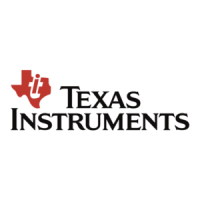
Do you have a question about the Texas Instruments 28xxx and is the answer not in the manual?
| Brand | Texas Instruments |
|---|---|
| Model | 28xxx |
| Category | Accessories |
| Language | English |
Important introductory information and related documentation.
Overview of the ePWM peripheral's design and programmability.
Details the seven submodules that compose an ePWM module and their interconnections.
Explains how ePWM module control and status registers are grouped by submodule.
Lists the seven key ePWM submodules and their main configuration parameters.
Explains the time-base submodule's role in event timing and synchronization for ePWM modules.
Describes the counter-compare submodule's function in generating events based on time-base counter values.
Explains the action-qualifier's role in waveform construction and PWM generation.
Explains the dead-band submodule's function in generating signal pairs with dead-band relationships.
Explains the PWM-chopper submodule's role in modulating PWM waveforms with a high-frequency carrier.
Explains the trip-zone submodule's function for detecting external fault conditions and responding to them.
Describes the event-trigger submodule's functions for managing interrupts and ADC conversions.
Explains the dead-band submodule's function in generating signal pairs with dead-band relationships.
Details the registers used to control and monitor the dead-band generator submodule.
Provides operational highlights for the dead-band submodule, including input source and output modes.
Explains the PWM-chopper submodule's role in modulating PWM waveforms with a high-frequency carrier.
Details the registers used to control the PWM-chopper submodule.
Highlights operational details of the PWM-chopper submodule, including carrier clock and one-shot features.
Shows simplified waveforms illustrating the PWM-chopper's chopping action.
Explains the trip-zone submodule's function for detecting external fault conditions and responding to them.
Details the registers used to control and monitor the trip-zone submodule.
Describes operational highlights and configuration options for the trip-zone submodule.
Illustrates the trip-zone submodule's control and interrupt logic.
Provides an overview of how multiple ePWM modules work together in a system.
Lists key configuration choices available for ePWM modules when used in multi-module systems.
Explains how to control multiple buck converters with independent PWM frequencies using ePWM modules.
Explains how to control multiple buck converters with the same PWM frequency using synchronized ePWM modules.
Describes controlling multiple Half-H bridge converters using ePWM modules.
Details controlling dual 3-phase inverters for motor control using ePWM modules.
Demonstrates using phase control between PWM modules for power topologies.
Explains controlling a 3-phase interleaved DC/DC converter using phase-offset PWM modules.
Describes controlling a Zero Voltage Switched Full Bridge (ZVSFB) converter using ePWM modules.
Describes the registers associated with the Time-Base (TB) submodule.
Describes the registers associated with the Counter-Compare (CC) submodule.
Describes the registers associated with the Action-Qualifier (AQ) submodule.
Describes the registers associated with the Dead-Band Generator (DB) submodule.
Details the control register for the PWM-Chopper (PC) submodule.
Describes the control and status registers for the Trip-Zone (TZ) submodule.
Describes the registers used to configure and control the Event-Trigger (ET) submodule.
Outlines the correct procedure for initializing ePWM peripheral interrupts to avoid spurious events.
Details modifications, additions, and deletions for revision D.